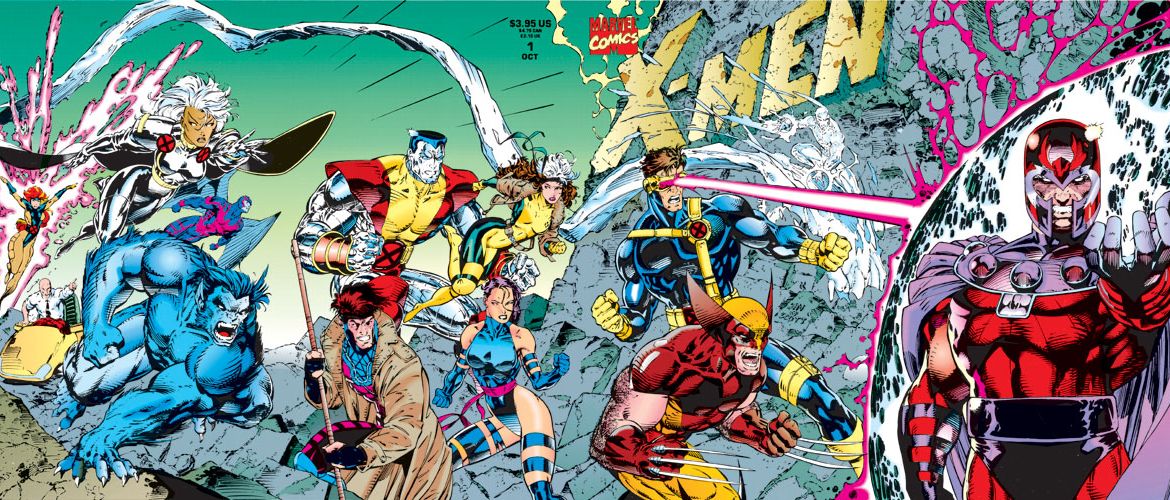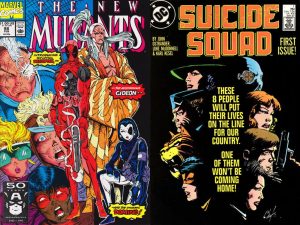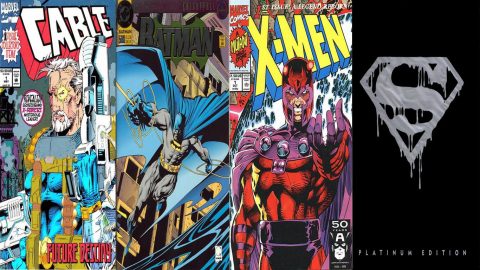
Welcome to Part 2 of our stroll down comic book memory lane. Good for some, bad for others, but either way a part of comic book history and an integral force in forming the current culture. Check out Part 1, if you missed it.
The Arse Falls Out Of It.
In a collector’s bubble like that which happened with collectible cards and comics prices for scarce back issues of which more can not be produced tend to skyrocket. This isn’t true of all back issues, but generally speaking a rising tide carries all ships and the ’90’s saw prices inflate on lots and lots of back issues on the secondary market. Happily, for comic book publishers, the demand for comic books extended well past the secondary market as the influx of newcomers created skyrocketing demand for their current products on the direct market as well.
To satisfy that demand the comic book publishers went all in, Marvel especially, as they tired to corner the market in an effort to protect their share of it and attract more buyers. “They went berserk with foil covers, die cut covers, foil was everywhere” said Smith. “At one time Marvel decided to flood the market with different titles so comic faithful would use all their budget only on Marvel titles. I think their target was two hundred titles a month and as you can imagine, quality control went out the window.”
It wasn’t just Marvel that was pumping the market full of books. DC Comics may not have had quite as ambitious a publication schedule but it was doing it’s part to produce foil and die cut collectors editions. Whereas Marvel was dry humping the market to try and save its financial skin, DC benefited greatly from the promotion that their “Death of Superman” story arc that was created when media outlets like CNN and the New York Times caught wind of the company’s intentions.
It didn’t matter that DC had ‘killed’ Superman twelve times in story arcs from 1944, 1950, 1957, 1958, 1961, 1962, 1963, 1966, 1968, 1984, and twice in 1987. By the time it was proposed in the annual writers retreat in 1991 the idea of killing Superman was a well worn troupe. In fact, within the Superman writers group Jerry Ordway had become famous for suggesting it, an account told by Larry Tye in his excellent history of DC’s leading character Superman: The High Flying History of America’s Most Enduring Hero. If we’ve learned anything about the 24-hour news cycle since 1992 is that context matters less then the headline. So when people caught wind that Superman was going to bite the dust almost no one knew that this was far from a historical first, and having no experience with comic books had no conception of the fact that death is never permanent.
People went nuts. Superman #75, the death issue, tallied the biggest one-day sale ever for a comic book, with nearly three million copies being printed in the first run, and six million when reprints are counted. The “Reign” issues which make up the middle part of the year long story arc sold more then a million copies a week month after month.
The interest generated by the auctions of Action Comics and Detective Comics coupled with the mass appeal of Superman #75, and X-men #1 – among other books – fueled an explosion print runs and publishing companies. Unfortunately, that explosion was built on a consumer base that wasn’t in it for the long haul based on a love of the medium. When the bubble burst these people were already out the door.
Increasing production to meet increased demand undermining value: check.
The Bubble Bursts.
 The mania that Superman #75 fueled in the direct market in 1992 last until about 1994 with ever diminishing returns as the years went on. And then, all of a sudden, the market collapsed.
The mania that Superman #75 fueled in the direct market in 1992 last until about 1994 with ever diminishing returns as the years went on. And then, all of a sudden, the market collapsed.
It didn’t take long for people to realize they were amassing collections that they weren’t going to be able to retire on. The vast majority of these new people entering the market weren’t looking for books on the secondary market, but rather buying new releases on the direct market that was suffering from wild inflation by speculators. Ultimately, it all became too much for the market to bear and the bubble inevitably and predictably burst.
The carnage inflicted by the creation of the bubble market and it’s quick merciless collapse nearly took the industry with it. Of the twenty odd publishing houses that opened shop during the bubble only a handful remained. Two-thirds of specialty comic shops that had opened during the period shuttered their doors, while comic book publishers saw their revenues collapse from a height of $900 million to a low of $300 million by the end of the decade.
More than two decades later the millions of comics that were printed in the early nineties are largely worthless. There are some exceptions to the rule, but the value of those books has never and will never reach the inflated heights of the ’90’s. That issue of Spawn #1 that people were willing to shell out upwards of a hundred bucks or more in many locations retails now at $15.00. The black bagged limited collector’s edition of Superman #75 once priced at a ridiculous $150.00 price point in some shops like my it was in my hometown can now be had for twenty dollars.
Today the speculation market still exists, but it’s rare for books printed in the last thirty years to be worth more then a hundred dollars – The Walking Dead #1 being the ultimate exception to the rule, although it stands apart for having been published in the early 2000s. Production runs of that book’s first edition was a tiny fraction of what a run of the mill X-Men, or Superman issue published in the ’90’s was. The Marvel cinematic universe and now DC’s cinematic universe are influencing prices and speculation is beginning to rear it’s head again. Story arcs that are featured in the movies are rising in value, some are beginning to take off, but any movies based on story arcs printed in the nineties probably won’t soar in the same way issues on the secondary market sky rocketed during the bubble. There are simply too many
of them out there, almost all bagged and boarded in mint condition.
There will be exceptions, of course.
New Mutants #98 featuring the first appearance of Deadpool is already hitting ridiculous prices. Try and find a copy of Suicide Squad #1 right now for less then $150.00. Before it was announced to be part of DC’s movie line up you could get it for less then $30.00. This is pure speculation of the same variety
for less then $150.00. Before it was announced to be part of DC’s movie line up you could get it for less then $30.00. This is pure speculation of the same variety
we saw in the nineties, but the prices for issues like these are largely fiction. There are enough of these issues around that once the movies have come and gone the prices will begin to fall back to Earth. The Walking Dead #1 is the ultimate exception to the rule, although it stands apart for having been published in the early 2000s. Production runs of that book’s first edition was a tiny fraction of what a run of the mill X-Men, or Superman issue published in the ’90’s was. Is $700-$800+ too much for a book published twelve years ago? I think it is, but the market has a different opinion.
Comic shop owners are reporting an influx of new customers thanks to the movies and show’s like The Big Bang Theory. That’s a good thing overall and let’s be clear, it’s nothing like the influx of people that flirted with comics in the nineties. Today, total monthly volume of first editions from all publishers for all books topped out around a million books in October 2015, in October 1995 – the year after the bubble burst – first editions published dwarfed that by double – and probably more if I had access to sales figures that included Marvel.
If you’re a life long collector like me the best advice I can give you is to wait it out. You may have to shell out a little more for the issues even after the movie speculation has passed, but don’t buy them now. Collect what you like, buy what gets you excited, and forget about the market. Print runs are much lower now then they were in the ’90s, but the practice of bagging and boarding books is standard practice today. Don’t buy anything on e-bay, variant covers – for the most part – won’t be worth much more, if anything more, then regular covers in a few years. They’re likely to mirror price difference between comics bought on the direct market in the ’90s and those bought from non-comic shop retailers; that is, there is no difference for 90% of the issues. Don’t bother talking to me about graded comics, and don’t waste your money on those either.
Comic books are meant to be fun. Even for a life long collector like me, I don’t put much stock in value. When I go searching for books at The Comic Hunter I’m looking for back issues to fill holes in my collection, or I’m buying story arcs and important issues to enhance the quality – not the value – of my collection. Sometimes that means that I have to dip my toes into the speculation market to get a book I want. I recently through down forty bucks an a copy of Infinity Gauntlet #1, I also dropped nearly sixty bucks buying the “Death in the Family” story arc with the famous death of Jason Todd (Batman’s second Robin). If you want the book, buy it, but don’t buy it on the false impression that you’re going to one day reap a huge windfall.
Just ask the millions of people holding on to copies of Superman #75, Jim Lee’s X-Men #1, or Spawn #1 how well they’re doing with their investment books. Buy what you like, collect what is fun, and love the medium.

















Very cool!